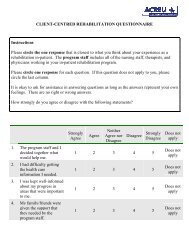Client-Centred Rehabilitation - Arthritis Community Research ...
Client-Centred Rehabilitation - Arthritis Community Research ...
Client-Centred Rehabilitation - Arthritis Community Research ...
Create successful ePaper yourself
Turn your PDF publications into a flip-book with our unique Google optimized e-Paper software.
applicable to our conceptualization of clientcentred<br />
rehabilitation, particularly that on<br />
patient focused care, we have included it<br />
because it is important to clarify the<br />
terminology and understand the different<br />
usages of these terms.<br />
2.3 Professional / <strong>Client</strong> Level<br />
Literature<br />
2.3.1 Occupational Therapy<br />
Literature: <strong>Client</strong>-<strong>Centred</strong> Practice<br />
In Canada, client-centred practice is<br />
considered a core concept of occupational<br />
therapy.<br />
Aclient-centred practice refers to<br />
collaborative approaches aimed at<br />
enabling occupation with clients who<br />
may be individuals, groups, agencies,<br />
governments, corporations or others.<br />
Occupational therapists demonstrate<br />
respect for clients, involve clients in<br />
decision making, advocate with and for<br />
clients in meeting clients= needs, and<br />
otherwise recognize clients= experience<br />
and knowledge.@ (p.49, Townsend et<br />
al., 1997)<br />
Guidelines for occupational therapy clientcentred<br />
practice were initially developed in<br />
response to national and international trends<br />
in health service delivery. Canada was the<br />
first to develop national, generic guidelines<br />
that defined client-centred practice and<br />
related process and outcome issues for<br />
quality assurance in occupational therapy<br />
(Townsend, Brintnell and Staisey, 1990).<br />
Work on the Canadian guidelines was<br />
initiated in 1979 when the Department of<br />
National Health and Welfare and the<br />
Canadian Association of Occupational<br />
Therapists (CAOT) convened a National<br />
10<br />
Task Force. Groundwork had been<br />
previously completed during the 1960's and<br />
1970's in Canada and the United States<br />
(Townsend et al., 1990).<br />
To date client-centred practice has focused<br />
on the individual client-therapist level.<br />
Some discussion of client-centredness at the<br />
department level has been introduced, with<br />
less attention afforded to organizational or<br />
system level implementation or impact of<br />
client-centred practice. Implementation of<br />
client-centred care at the organization level<br />
has been difficult with issues such as lack of<br />
interdisciplinary care serving as a barrier to<br />
organization level implementation of clientcentred<br />
care (Gage, 1994).<br />
2.3.1.1 Themes and Components of<br />
<strong>Client</strong>-<strong>Centred</strong> Practice<br />
The goal of client-centred practice Ais to<br />
create a caring, dignified and empowering<br />
environment in which clients truly direct the<br />
course of their care and call upon their inner<br />
resources to speed the healing process@ (p.<br />
128, Matheis-Kraft, Loinger and York,<br />
1990). In order for this to occur a shift in<br />
power from the therapist to the client must<br />
be realized with client empowerment as key<br />
(Gage and Polatajko, 1995).<br />
What constitutes a client? In the Canadian<br />
occupational therapy context clients are<br />
defined as: Aindividuals who may have<br />
occupational problems arising from medical<br />
conditions, transitional difficulties, or<br />
environmental barriers, or clients may be<br />
organizations that influence the occupational<br />
performance of particular groups or<br />
populations@ (p. 50, Townsend et al., 1997).<br />
Six core concepts of client-centred practice<br />
have been identified (Law et al., 1990; Law,<br />
Baptiste and Mills, 1995):








